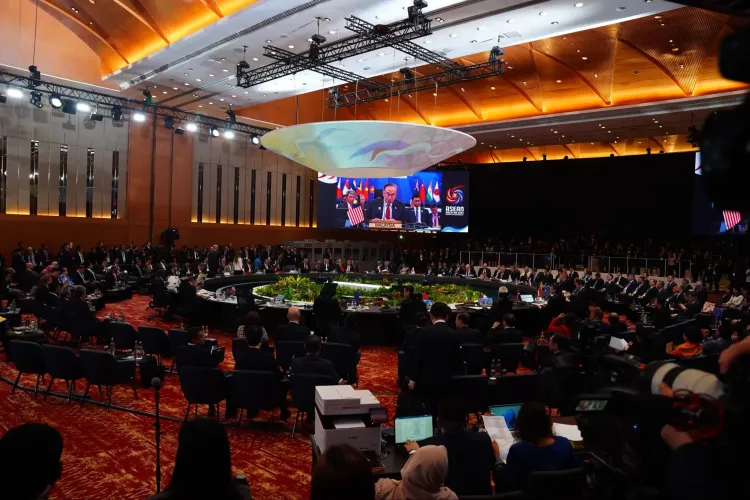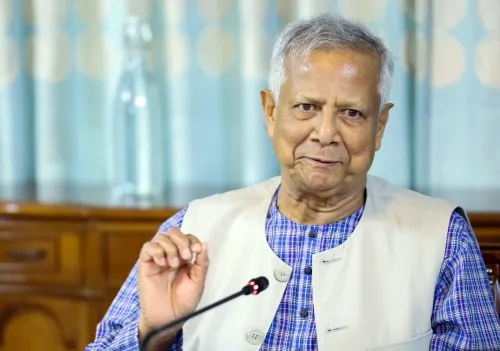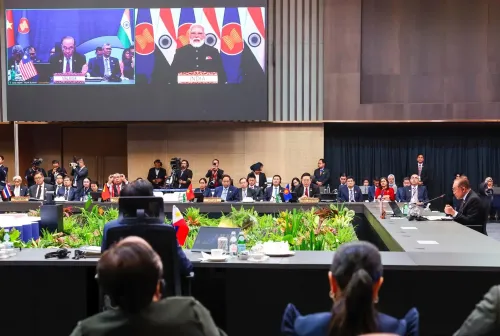How Will the East Asia Summit 2025 Strengthen Disaster Resilience?

Synopsis
Key Takeaways
- Commitment to disaster resilience by EAS countries.
- Localized anticipatory actions are effective in reducing disaster impacts.
- Importance of community involvement in disaster management.
- Need for enhanced regional collaboration and sharing best practices.
- Integration of local knowledge in disaster risk reduction efforts.
Kuala Lumpur, Oct 28 (NationPress) The nations participating in the East Asia Summit (EAS) have reaffirmed their collective dedication to enhancing disaster resilience throughout the region, urging immediate action to bolster the ASEAN Community's ability to endure and recover from calamities.
During the 20th East Asia Summit, held under Malaysia's ASEAN Chairmanship on Monday in Kuala Lumpur, the member countries adopted a declaration emphasizing the escalating complexity of global disaster risks, driven by environmental challenges, rapid urban growth, and socio-economic vulnerabilities.
In acknowledgment of the rising frequency and severity of disasters, the Summit referenced key commitments such as the 2009 Cha-am Hua Hin Statement and the 2014 EAS Statement on Rapid Disaster Response, which stress regional cooperation in disaster preparedness, response, and recovery.
The leaders observed that localized anticipatory action has been proven to be effective in mitigating disaster impacts. Localisation, which involves the active involvement of local authorities, communities, organizations, and the private sector, was identified as a fundamental aspect of successful disaster management.
They also reiterated the importance of localisation as highlighted in crucial frameworks and agreements, including the ASEAN Agreement on Disaster Management and Emergency Response (AADMER), the ASEAN Declaration on One ASEAN, One Response, the ASEAN Framework on Anticipatory Action in Disaster Management, and the Sendai Framework for Disaster Risk Reduction 2015-2030.
These documents collectively emphasize the significance of community-driven approaches and the incorporation of local knowledge and capacities in disaster risk reduction.
The Summit recognized that localized anticipatory action can diminish physical, social, and economic vulnerabilities, providing tailored solutions to specific threats. It highlighted the necessity of empowering local actors in disaster preparedness and response, ensuring their central role in building resilience and alleviating impacts.
The declaration stressed the development of science and technology-based, locally customized, and regularly updated disaster risk assessments, hazard maps, and impact-based early warning systems as essential components of anticipatory strategies.
Understanding the value of risk-informed investment, the Summit asserted that prudent planning and resource allocation can lead to cost-effective and equitable solutions for long-term community resilience.
The participating nations declared their commitment to meeting regional and international obligations, including those outlined in AADMER, ASEAN SHIELD, and the Sendai Framework, while reinforcing the role of local communities in responsive disaster management.
The declaration called for enhanced regional collaboration through sharing best practices, capacity building, and resource mobilization, facilitated by organizations such as the ASEAN Coordinating Centre for Humanitarian Assistance (AHA Centre).
It encouraged investments in local anticipatory action capabilities, infrastructure, and early warning systems, integrating disaster risk reduction into post-disaster recovery and reconstruction efforts.
The countries also reaffirmed their commitment to fostering multi-stakeholder partnerships among EAS participating nations, enhancing collaboration with the ASEAN Committee on Disaster Management (ACDM) and various stakeholders to bolster capacities and resources.
The Summit urged cooperation to enhance local early warning systems, mobile alerts, GIS-based community risk mapping, and AI-powered forecasting models for effective dissemination of early warning information.
The declaration further supported the active involvement of local actors in regional and community-led disaster initiatives and the application of context-specific anticipatory actions. It stressed the importance of leveraging local culture and wisdom, acknowledging communities as first responders in disaster risk reduction.
The Summit explored creating national-level guidelines and mechanisms, including pre-arranged financing, to facilitate rapid decision-making and execution of anticipatory actions at the local level.
It also advocated for incorporating localization principles into national and regional disaster management frameworks, ensuring their effective implementation through EAS statements.









